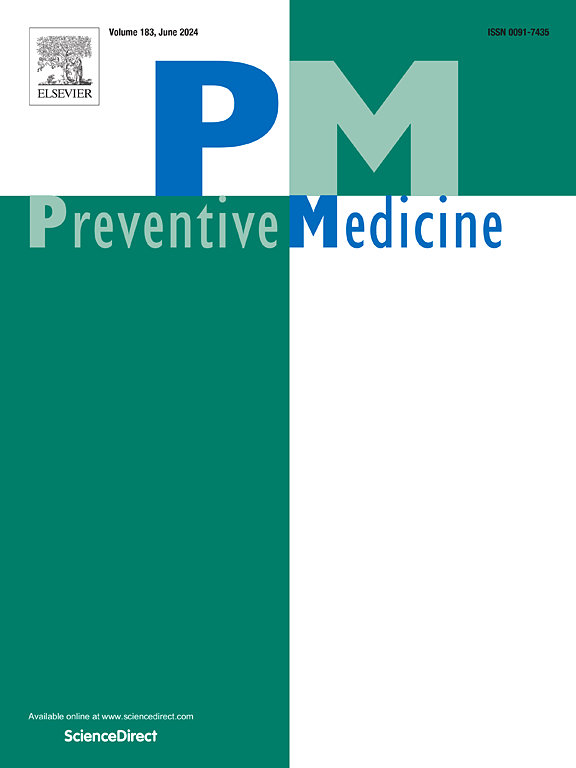Potentially preventable hospitalizations among American Indian and Alaska Native adults, 2016–2021
IF 3.2
2区 医学
Q1 MEDICINE, GENERAL & INTERNAL
引用次数: 0
Abstract
Objective
Potentially preventable hospitalizations are inpatient admissions for a standard set of selected acute illnesses and chronic conditions that might have been avoided with preventive care or outpatient management. During 2010–2012, Alaska Native adults had higher rates of potentially preventable hospitalizations compared to other adults in Alaska. We evaluated potentially preventable hospitalizations among American Indian/Alaska Native (AI/AN) adults in the United States during 2016–2021.
Methods
We used hospital discharge data from the Indian Health Service National Patient Information Reporting System (NPIRS) to calculate and compare average annual age-adjusted rates of potentially preventable hospitalizations per 1000 AI/AN adults for two acute conditions (community-acquired pneumonia and urinary tract infection) and four chronic conditions (diabetes, heart failure, asthma/chronic obstructive pulmonary disease, and hypertension).
Results
Of 310,889 hospitalizations among AI/AN adults, 40,400 (13 %) were defined as potentially preventable for an annual rate of 7.6 per 1000 persons. Rates were stable during 2016–2019 (8.7 per 1000) but declined during 2020–2021 (5.9 per 1000), likely related to the COVID-19 pandemic. Older adults and rural residents had significantly higher rates of potentially preventable hospitalizations across all six conditions assessed, with community-acquired pneumonia having the highest hospitalization rate among adults aged ≥65 years (5.2 per 1000).
Conclusions
Targeted preventive care and appropriate outpatient management for AI/AN elders living in rural areas might help improve health and reduce medical costs through decreased hospitalizations. Vaccination against respiratory infections could have the greatest impact in reducing preventable hospitalizations among AI/AN adults.
2016-2021年美国印第安人和阿拉斯加原住民成年人中可能可预防的住院情况
目的潜在可预防的住院是指因一系列标准的急性疾病和慢性疾病而住院的患者,这些疾病本可以通过预防性护理或门诊管理来避免。在2010-2012年期间,与阿拉斯加的其他成年人相比,阿拉斯加土著成年人的潜在可预防住院率更高。我们评估了2016-2021年美国印第安人/阿拉斯加原住民(AI/AN)成年人中潜在可预防的住院情况。方法我们使用印度卫生服务国家患者信息报告系统(NPIRS)的出院数据来计算和比较每1000名AI/AN成人中两种急性疾病(社区获得性肺炎和尿路感染)和四种慢性疾病(糖尿病、心力衰竭、哮喘/慢性阻塞性肺病和高血压)的潜在可预防住院的平均年年龄调整率。结果在AI/AN成人310,889例住院中,40,400例(13%)被定义为潜在可预防的,年发病率为每1000人7.6例。2016-2019年期间,发病率保持稳定(每千人8.7例),但在2020-2021年期间下降(每千人5.9例),这可能与COVID-19大流行有关。在所有评估的六种情况中,老年人和农村居民的潜在可预防住院率明显更高,社区获得性肺炎在≥65岁的成年人中住院率最高(每1000人中有5.2人)。结论对农村AI/AN老年人实施有针对性的预防保健和适当的门诊管理,可通过减少住院率来改善健康状况,降低医疗费用。针对呼吸道感染的疫苗接种可能对减少AI/AN成人中可预防的住院治疗产生最大影响。
本文章由计算机程序翻译,如有差异,请以英文原文为准。
求助全文
约1分钟内获得全文
求助全文
来源期刊

Preventive medicine
医学-公共卫生、环境卫生与职业卫生
CiteScore
7.70
自引率
3.90%
发文量
0
审稿时长
42 days
期刊介绍:
Founded in 1972 by Ernst Wynder, Preventive Medicine is an international scholarly journal that provides prompt publication of original articles on the science and practice of disease prevention, health promotion, and public health policymaking. Preventive Medicine aims to reward innovation. It will favor insightful observational studies, thoughtful explorations of health data, unsuspected new angles for existing hypotheses, robust randomized controlled trials, and impartial systematic reviews. Preventive Medicine''s ultimate goal is to publish research that will have an impact on the work of practitioners of disease prevention and health promotion, as well as of related disciplines.
 求助内容:
求助内容: 应助结果提醒方式:
应助结果提醒方式:


